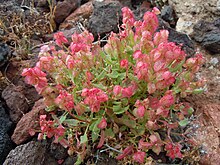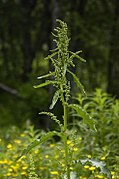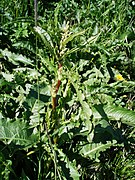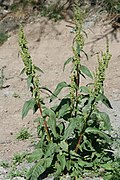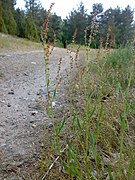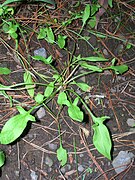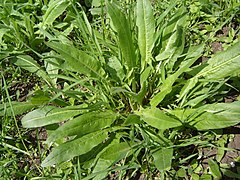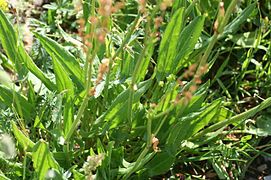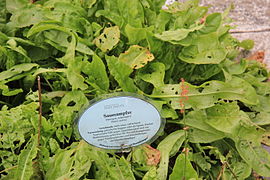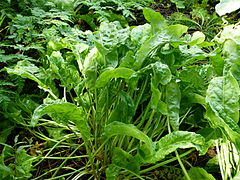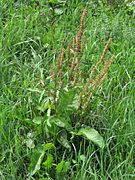Dock
| Dock | ||||||||||||
|---|---|---|---|---|---|---|---|---|---|---|---|---|

Alpine dock ( Rumex alpinus ) |
||||||||||||
| Systematics | ||||||||||||
|
||||||||||||
| Scientific name | ||||||||||||
| Rumex | ||||||||||||
| L. |
Sorrel ( Rumex outdated, even monks rhubarb ) is a plant genus of the family of Knotweed (Polygonaceae).
The genus occurs with about 130 species mostly in the temperate regions of the northern hemisphere . The species are sometimes difficult to distinguish, as both flowers and fruits and basal leaves are required for an exact determination. So the water dock differs from the pond dock only in the lack of calluses on the tepals and in the area of distribution that also extends into the mountain regions.
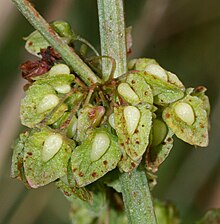
description
Dockers are usually herbaceous plants with perennial species , more rarely annual species or shrubs. The stems are erect, rarely ascending or prostrate; they are branched. The leaves are basal and alternate; they are entire or wavy at the edge. The ochrea is cylindrical and membranous. The inflorescence is usually terminal, sometimes terminal and axillary; it is a grape or a panicle . The flower stalk is articulated. The flowers are hermaphroditic or unisexual. The inflorescence consists of 6 tepals , which are still present at the fruiting time and can then be enlarged. There are six stamens and three styles; the scar is feathery. The fruits are triangular and ovoid or ellipsoidal. The Rumex species are characterized by the following characteristic features:
- The three inner tepals that remain on the fruit and envelop it are called valves .
- As callus is called knotty-hard, cartilage-like swellings on the Valven. Depending on the type, only some or all of the valves can have callouses evenly or unevenly. The calluses can also be absent entirely.
Systematics and distribution
Here is a selection of species of the genus Ampfer ( Rumex L. ):
- Meadow sorrel ( Rumex acetosa L. )
- Little sorrel ( Rumex acetosella L. )
- Mountain sorrel ( Rumex alpestris Jacq. , Syn .: Rumex arifolius All. )
- Alpine dock, Alpine monk's rhubarb ( Rumex alpinus L. )
- Water dock, water monk's rhubarb ( Rumex aquaticus L. )
- Bull's head dock ( Rumex bucephalophorus L. ): It is originally found in Macaronesia, North Africa, Portugal, Spain, France, Italy, Croatia, Albania, Greece, Turkey, Cyprus, Syria, Lebanon, Israel and the Sinai Peninsula.
- Squat dock ( Rumex confertus Willd. ): It occurs in Italy, Hungary, Slovakia, the Baltic States, Belarus, Ukraine, Romania, Kazakhstan, Siberia, Far Eastern Asian Russia and Xinjiang .
- Ball dock ( Rumex conglomeratus Murray )
- Curled dock ( Rumex crispus L. )
- River dock ( Rumex hydrolapathum L. )
- Vegetable dock ( Rumex longifolius DC. ): It occurs in northern, central, eastern and southwestern Europe, in the Caucasus, in Siberia, China and Japan.
- Canary dock ( Rumex lunaria L. )
- Shore dock or beach dock ( Rumex maritimus L. )
- Snow dock , snow sorrel ( Rumex nivalis Hegetschw. )
- Stump-leaf dock ( Rumex obtusifolius L. )
- Marsh dock ( Rumex palustris Sm. )
- Garden dock, real monk's rhubarb ( Rumex patientia L. ): It is native to Central, Eastern and Southeastern Europe, Western Asia, the Caucasus, Central Asia, India, Pakistan, Nepal, Siberia, China, Mongolia and in East Asian Russia.
- Beautiful dock ( Rumex pulcher L. ): It is originally found in Europe north to Great Britain, in North Africa, in Macaronesia, in West Asia, in the Caucasus and in Central Asia. It is a neophyte in Australia, North America, Mexico, Cuba, and South America.
- Tangier dock ( Rumex roseus L. , Syn .: Rumex tingitanus L. ): It occurs in Portugal, Spain, France, Morocco, Algeria, Tunisia, Libya, Israel and Jordan.
- Grove dock , blood dock ( Rumex sanguineus L. )
- Shield sorrel, shield sorrel ( Rumex scutatus L. )
- Narrow-leaf dock ( Rumex stenophyllus Ledeb. ): It occurs in Central, Eastern and Southeastern Europe, in Central Asia, in China and in Mongolia.
- Ostrich-flowered sorrel ( Rumex thyrsiflorus Fingerh. )
- Willow-leaf dock ( Rumex triangulivalvis (Danser) Rech.f. ): It is native to Canada and the United States.
- Indian sorrel ( Rumex vesicarius L. ): It occurs in North Africa, Greece, West Asia, India and the Malay Peninsula.
ingredients
The value of dock species as a forage crop is usually low. Since they contain oxalic acid as an ingredient , they can lead to symptoms of poisoning in ruminants and horses if they are ingested in large quantities . The reason for poisoning is a decrease in the blood calcium level.
use
Many types of dock are used as an ingredient in aromatic salads, herbal quark and herbal soups. They generally contain a significant amount of vitamins A and C. Due to the oxalic acid content, dock should only be consumed in moderation or with dairy products.
Dock can also be sautéed in butter. If dock like spinach or Swiss chard is cooked, an enamelled pot should be used, as bare steel and aluminum pots react with the oxalic acid and cause a metallic aftertaste.
Dock species such as water dock and river dock used to be used as a medicinal plant against ulcers. Vaccine semen was thought to have an effect on dysentery, stomach ailments and disgust for food as well as against scorpion venom. Preparations from the root should be helpful for rashes, swelling of the glands and toothache as well as ulcers on the ear. The plant was also thought to relieve itching and be effective against jaundice.
Combat
A dock fork can be useful for combating dock species .
gallery
- Vegetable dock ( Rumex longifolius )
- Little sorrel ( Rumex acetosella )
- Common Sorrel ( Rumex acetosa )
- Blunt-leaved dock ( Rumex obtusifolius )
literature
- Manfred A. Fischer, Wolfgang Adler, Karl Oswald: Excursion flora for Austria, Liechtenstein and South Tyrol . 2nd, improved and enlarged edition. State of Upper Austria, Biology Center of the Upper Austrian State Museums, Linz 2005, ISBN 3-85474-140-5 .
- Karl Heinz Rechinger , John Robert Akeroyd: Rumex L. In: TG Tutin, NA Burges, AO Chater, JR Edmondson, VH Heywood, DM Moore, DH Valentine, SM Walters, DA Webb (eds.): Flora Europaea . 2nd, revised edition. Volume 1: Psilotaceae to Platanaceae . Cambridge University Press, Cambridge / New York / Melbourne 1993, ISBN 0-521-41007-X , pp. 99-107 (English, limited preview in Google Book Search).
Individual evidence
- ↑ a b c d e f g h i Rumex in the Germplasm Resources Information Network (GRIN), USDA , ARS , National Genetic Resources Program. National Germplasm Resources Laboratory, Beltsville, Maryland. Retrieved August 15, 2017.
- ↑ Explanation of the effects of oxalic acid , Werner Carlos Kessler (nutrition coach), accessed in August 2015
- ↑ Use of sorrel in the kitchen in a publication by Thorbecke- Verlag, accessed in August 2015
- ↑ Hans Zotter : Ancient medicine. The collective medical manuscript Cod. Vindobonensis 93 in Latin and German. Academic printing and Verlagsanstalt, Graz 1980 (= Interpretationes ad codices. Volume 2); 2nd, improved edition, ibid. 1986, ISBN 3-201-01310-2 , pp. 76-79 and 336-339 (on the plant lapatium and rumex , of which four species were distinguished).

